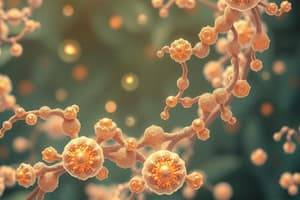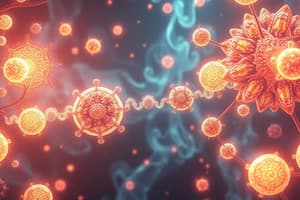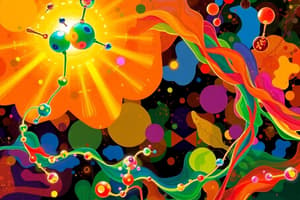Podcast
Questions and Answers
Which organelle is primarily responsible for the synthesis of proteins within the cell?
Which organelle is primarily responsible for the synthesis of proteins within the cell?
- Golgi apparatus
- Mitochondria
- Ribosomes (correct)
- Lysosomes
In a plant cell, what is the main function of the large central vacuole?
In a plant cell, what is the main function of the large central vacuole?
- Energy production through cellular respiration.
- Storage of water, nutrients and waste products. (correct)
- Synthesis of lipids for the cell membrane.
- Modification and packaging of proteins
Which type of passive transport involves the movement of water across a semi-permeable membrane?
Which type of passive transport involves the movement of water across a semi-permeable membrane?
- Active Transport
- Diffusion.
- Osmosis. (correct)
- Facilitated Diffusion.
If a cell is placed in a hypertonic solution, what will likely occur?
If a cell is placed in a hypertonic solution, what will likely occur?
What is the key difference between the rough endoplasmic reticulum (RER) and the smooth endoplasmic reticulum (SER)?
What is the key difference between the rough endoplasmic reticulum (RER) and the smooth endoplasmic reticulum (SER)?
Which biomolecule primarily functions as a source of quick energy and structural support in living organisms?
Which biomolecule primarily functions as a source of quick energy and structural support in living organisms?
According to the Atwater system, which of the following yields the most energy per gram consumed?
According to the Atwater system, which of the following yields the most energy per gram consumed?
In the context of data presentation, what type of graph is most suitable for displaying proportions of a whole?
In the context of data presentation, what type of graph is most suitable for displaying proportions of a whole?
Which of these is the correct ordering of the cell theory's tenets?
Which of these is the correct ordering of the cell theory's tenets?
Which domain of life includes organisms with membrane-bound organelles and a defined nucleus?
Which domain of life includes organisms with membrane-bound organelles and a defined nucleus?
Which characteristic is specific to prokaryotic cells?
Which characteristic is specific to prokaryotic cells?
Which of the following is not a function of proteins in living organisms?
Which of the following is not a function of proteins in living organisms?
What information is typically placed on the Y-axis of a graph?
What information is typically placed on the Y-axis of a graph?
Flashcards
Nucleus
Nucleus
Contains genetic material (DNA) and controls cell activities.
Mitochondria
Mitochondria
Powerhouse of the cell, responsible for energy production through cellular respiration.
Ribosomes
Ribosomes
Cell structures responsible for protein synthesis.
Passive Transport
Passive Transport
Signup and view all the flashcards
Osmosis
Osmosis
Signup and view all the flashcards
Carbohydrates
Carbohydrates
Signup and view all the flashcards
Lipids
Lipids
Signup and view all the flashcards
Proteins
Proteins
Signup and view all the flashcards
Atwater System
Atwater System
Signup and view all the flashcards
Prokaryotic Cells
Prokaryotic Cells
Signup and view all the flashcards
Eukaryotic Cells
Eukaryotic Cells
Signup and view all the flashcards
Cell Theory
Cell Theory
Signup and view all the flashcards
Data Graphs
Data Graphs
Signup and view all the flashcards
Signup and view all the flashcards
Study Notes
Biomolecules
-
Carbohydrates: Provide energy and structural support
- Monosaccharides: Simple sugars (e.g., glucose)
- Polysaccharides: Complex sugars (e.g., starch, glycogen)
- Examples: Glucose (C₆H₁₂O₆), starch (plant energy storage), glycogen (animal energy storage)
-
Lipids: Store energy, insulate, and form cell membranes
- Types: Fats, oils, phospholipids, steroids
- Structure: Glycerol + fatty acids
- Examples: Saturated fats (solid at room temperature), unsaturated fats (liquid at room temperature)
-
Proteins: Perform diverse functions; enzymes, structural support, transport, and immunity
- Structure: Chains of amino acids linked by peptide bonds, organized into primary, secondary, tertiary, and quaternary structures
- Examples: Hemoglobin, collagen, enzymes like amylase
Atwater System
- Method to calculate food energy content
- Energy values (kcal/g):
- Carbohydrates: 4
- Proteins: 4
- Lipids: 9
- Alcohol: 7
- Used in nutrition to determine food energy.
Data Presentation
-
Data Tables: Organize data for analysis.
- Include column headings (variables), rows (data points), and units.
- Key: Clarity, precision, and correct labeling.
-
Data Graphs: Visualize data trends and comparisons
- Types: Bar graphs (comparing quantities), line graphs (showing trends over time), pie charts (showing proportions)
- Elements: Clear labels (axes, units), title, appropriate scales.
Cell Theory
- Core tenets:
- All living things are made of cells.
- Cells are the fundamental units of structure and function.
- Cells arise from pre-existing cells.
Domains of Life
-
Bacteria: Prokaryotic, unicellular organisms, no membrane-bound organelles.
-
Archaea: Prokaryotic, unicellular, distinct from bacteria, often adapted to extreme environments.
-
Eukarya: Eukaryotic, including unicellular and multicellular organisms (plants, animals, fungi, protists), cells with membrane-bound organelles.
Cell Types
-
Prokaryotic Cells: Lack a nucleus, smaller, simpler structure, DNA in a nucleoid region (e.g., bacteria, archaea)
-
Eukaryotic Cells: Contain a nucleus, larger, more complex, membrane-bound organelles (e.g., animals, plants, fungi, protists)
Cell Structures
-
Nucleus: Contains DNA, controls cell activities.
-
Mitochondria: "Powerhouse of the cell," generate energy via cellular respiration.
-
Ribosomes: Synthesize proteins.
-
Endoplasmic Reticulum (ER):
- Rough ER: Studded with ribosomes, involved in protein synthesis.
- Smooth ER: Involved in lipid synthesis and detoxification.
-
Golgi Apparatus: Modifies, sorts, and packages proteins and lipids.
-
Lysosomes: Contain digestive enzymes that break down waste.
-
Cytoskeleton: Provides structural support and facilitates cell movement.
-
Cell Membrane: Regulates what enters and exits the cell, selectively permeable.
Animal vs. Plant Cells
-
Animal Cells: Lack cell walls, have smaller vacuoles, and contain centrioles.
-
Plant Cells: Have cell walls made of cellulose, a large central vacuole, and chloroplasts for photosynthesis.
Passive Transport
- Movement across the cell membrane without energy input.
- Diffusion: High to low concentration.
- Facilitated Diffusion: Uses transport proteins to move molecules.
- Osmosis: Water movement across a membrane.
- Key concepts: Concentration gradients, equilibrium, hypertonic, hypotonic, isotonic solutions.
Studying That Suits You
Use AI to generate personalized quizzes and flashcards to suit your learning preferences.




